COBs for Growing Plants
EconoLux Industries
Ltd., is
the exclusive manufacturer of the revolutionary Mc series of plant-light-on-chip grow-light COBs. .
These COBs are scientifically designed to have a close match to the McCree Curve and natural sunlight, and they allow you to choose
what level of match to the
McCree Curve your project needs. The Mc85, and Mc90 are provided on low-cost PCB bases, while
the premium Mc95+ COB is provided on a traditional nickel-coated copper and plastic base.
We also make custom COBs to suit your desired spectrum.

|
EconoLux Industries invented and introduced the world's first
McCree curve COB in April of 2017
The COB, had a 90+% match to the McCree curve. Since than, we have
improved our LED COB technology with the improvement of our
MC95+ COB to a 95%+ match to the McCree Curve.
We have also recently introduce our lower cost PCB based
Mc85 and Mc90 COBs which have an 85% and 90% match to the
McCree curve. Our unique Mc COB
series is based on our extensive R&D and our proprietary, self developed phosphor technology. We can make this technology
available to you to build your own grow-lights with a superior spectrum and PPFD.
|
 |
In June of 2019 we introduced the HPSH COB, designed to
enhance, and supplement the spectrum of light provided by
popular High Pressure Sodium (HPS) lamps. The HPSH adds
additional UV, Blue, Red and Infra Red light to the HPS
lamps. It is well known that HPS lamps, while useful for
growing plants, have a surfeit of green to yellow-orange
light, but are deficient in other wavelengths of light which
are vital to plants, especially flowering plants. By
adding 2 to 4 of the HPSH COBs (in suitable fixtures), the
deficiency in the HPS spectrum can be corrected for better
crop yields. |
|
|
Choose the best COB for
your needs, or have us custom design one to suit your requirements -
Higher wattages and custom configurations are also available.
|
THE Mc SERIES OF PLANT-GROWING LED
COBS WITH CLOSE MATCH TO THE McCREE CURVE
Click the image below to go direct to the details |

Mc85:
This
low-cost 100W COB offers full spectrum light from 410nm ~ 770nm with an average 85% match to the McCree curve
(usually 84.5% to 85.8%). |

Mc90: This low-cost 100W COB offers full spectrum light from 395nm
~ 780nm with an average 90% match to the McCree curve (usually 91% to 93.5%). |

Mc95+:
This
premium, 24 band, 100W COB offers full spectrum light from 385nm to 780nm with an average 95% match to the McCree
curve (usually 94.5% to 96.8%).. |
|
Click for
Mc Series COB Comparison Table |

|
ELPL-Mc85 Low Cost, Full-spectrum (410nm ~ 770nm), 100W PCB COBs - 85% Average Match to the McCree curve |
 |
The Mc85 Series of LED COBs are available in 100W and custom size/configuration models. The
ELPL-Mc85 COBs are full spectrum - from 410nmn to 770nm - LED grow-light-on-a-chip PCB COBs that offers an average 85% match to the McCree curve,
and are also a close match to natural sunlight (see Spectrum Graph below) - see
also
What Light do Plants Need?
The McCree curve is ideal for 'full cycle' growing of all different kinds of plants, both leafy green types
(Lettuce, Chard, Spinach, Basil & other herbs, Micro-Greens. etc.) as well as flowering/fruiting
types of plants (Tomatoes, Cucumbers, Squash, Peppers, Cannabis, etc), and also decorative and house
plants (see client photo on right). |
 |
Spectrum
The ELPL-Mc85 Series of light-engines has an average match of 85% to the McCree curve,
as well as a close match to the spectrum of sunlight.
The chart (right) shows the PPFD spectrum of the Mc85 COB, with the McCree curve (as a dashed purple line - set to
85%), and with the spectrum of
sunlight (solid red line set to 85%). We use the PPFD
spectrum as its is a better indicator of the photosynthesis
effects that can be expected from a light source.
You can see from the Chart, the ELPL-Mc85 series has a true full spectrum output. from
410~770nm. The Mc
series of COBs are the world's only LED light source with such a close match to the McCree curve
(models from 85% to 95+%).
|
 |
Mc85 Comparison Graphs
The graphs (below), from our plant/grow light spectrometer, measuring in PPFD (PAR)*, shows a comparisons of the ELPL-Mc85
100W COBTM
spectrum, to various standard curves for Chlorophyll A, Chlorophyll B, and Beta
Carotene - the light absorbing compounds in plants responsible for growth. The Mc85 COB grow light engine's match
to these curves is quite close due to the ELPL-Mc85COBs careful construction, and the use of our self-developed
and proprietary Mc85 phosphor coating.

|
UV (380~399nm) |
BLUE
(400~499nm) |
GREEN
(500~599nm) |
RED
(600~700nm) |
Infra Red
(701~780nm) |
TOTALS |
| 0.82 PPFD |
135.00 PPFD |
306.94 PPFD |
292.30 PPFD |
75.09 PPFD |
810.15 PPFD |
| 0.10% |
16.66% |
37.89% |
36.08% |
9.27% |
100% |
|
|
|
ELPL-Mc85 - SPECIFICATIONS |
|
ELPL-Mc85 Light-engine Parameters |
100 Watts |
|
Nominal Wattage:
|
100 W |
|
Power: (constant current driver recommended) |
30~32VDC @ 3.35~3.1A |
|
Dimensions:
|
45.5mm X 40mm X 2mm |
| Mounting hole Grid dimensions (4
holes of 3.4mm diameter) |
34mm X 34mm |
|
LED Lifespan:
|
50,000 Hours |
| Active light emitting area (works
with mounts & lenses for typical 100W COBs) |
23.3mm X 23.3mm |
|
Colour Temperature: (Kelvin) |
4,966K |
|
Illuminance:#1 (Measured using the CIE curve
- NO reflector or lens used) |
30,295 Lux |
|
Beam Angle: |
120°#1 |
|
Total PAR/PPFD* Output: |
810.14 @ 30.5cm (12") |
|
DLI: (Daily Light Integral - mol/m2/day) |
40.7 @ 30.5cm (12") |
|
Efficiency #2:
Using a quantum PAR meter; NO reflector or lens used |
3.15 µmol/J |
|
Efficiency
#2
(at 30.5cm - 12"): Using a quantum PAR meter; NO reflector or
lens used |
8.10 PPFD/Watt |
*Note 1: Light energy for plants is measured as Photosynthetic Active Radiation (PAR),
with light falling onto a surface measured as Photosynthetic Photon Flux Density (PPFD)
#1 Note: These measurements were made at a distance of 30.5cm, (12") with no lens
or reflector used. Readings will vary with distance from the COB, and the use of supplementary
optics (reflector/lens). The spectrum of the COBs may vary by +/- 2% due to minor
variations in the LED chips output.
#2 Note:
We provide the electrical efficiency in industry standard µmol/J,
.and we also use PPFD/Watt as most professional plant/grow light manufacturers provide the
average PAR/PPFD and the actual power draw (wall watts), making it simpler to compare different lights (measured at the same
distance from from the light to the PAR/PPFD meter). |

|
|
ELPL-Mc90 Medium-Low Cost, Full-spectrum (395nm ~ 780nm), 100W PCB COBs -
90% Average Match to the McCree curve |
 |
The Mc90 Series of LED COBs
are available in 100W and custom size/configuration models. The ELPL-Mc90 COBs are
full spectrum - from 395nmn to 780nm - LED grow-light-on-a-chip
PCB COBs, that offer an average 90% match to
the McCree curve,
and are also a close match to natural sunlight (see Spectrum
Graph below) - also see
What Light do Plants Need?
The McCree curve is ideal for 'full cycle' growing of all different kinds of plants.
The Mc90 is ideal for leafy green types
(Lettuce, Chard, Spinach, Basil & other herbs, Micro-Greens. etc.)
due to it's enhanced blue, and also ideal for flowering/fruiting
types of plants (Tomatoes, Cucumbers, Squash, Peppers, Cannabis, etc), as well as
decorative and house plants. |
Spectrum
The ELPL-Mc90 Series of light-engines has an average match of 90% to the McCree curve,
as well as a close match to the spectrum of sunlight.
The chart (right) shows the PPFD spectrum of the Mc90 COB, with the McCree curve (as a dashed purple line - set to
90%), and with the spectrum of sunlight (solid red line set to 90%) - note the enhanced UV
and blue light in this model. We use the PPFD
spectrum as its is a better indicator of the photosynthesis effects expected from a light source.
You can see from the Chart, the ELPL-Mc90 series has a true
full spectrum output, from 395~780nm.
|
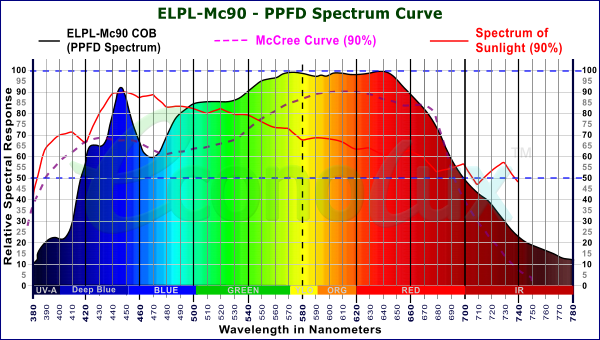 |
Mc90 Comparison Graphs
The graphs (below), from our plant/grow light spectrometer, measuring in PPFD (PAR)*, shows a comparisons of the ELPL-Mc90
100W COBTM spectrum, to various standard curves for Chlorophyll A, Chlorophyll B, and Beta
Carotene - the light absorbing compounds in plants responsible for growth.
The Mc90 COB grow-light engine's match to these curves is very close due to the ELPL-Mc90 COBs careful construction, and
the use of our self-developed and proprietary phosphor coating.

|
UV (380~399nm) |
BLUE
(400~499nm) |
GREEN
(500~599nm) |
RED
(600~700nm) |
Infra Red
(701~780nm) |
TOTALS |
| 8.11 PPFD |
164.63 PPFD |
235.14 PPFD |
226.67 PPFD |
50.53 PPFD |
685.08 PPFD |
| 1.18% |
24.03% |
34.32% |
33.09% |
7.38% |
100% |
|
|
ELPL-Mc90 - SPECIFICATIONS |
|
ELPL-Mc90 Light-engine Parameters |
100 Watts |
|
Nominal Wattage:
|
100 W |
|
Power: (constant current driver recommended) |
30~32VDC @ 3.35~3.1A |
|
Dimensions:
|
45.5mm X 40mm X 2mm |
| Mounting hole Grid dimensions (4
holes of 3.4mm diameter) |
34mm X 34mm |
|
LED Lifespan:
|
50,000 Hours |
| Active light emitting area (works
with mounts & lenses for typical 100W COBs) |
23.3mm X 23.3mm |
|
Colour Temperature: (Kelvin) |
4,966K |
|
Illuminance:#1 (Measured using the CIE curve
- NO reflector or lens used) |
36,548 Lux |
|
Beam Angle: |
120°#1 |
|
Total PAR/PPFD* Output: |
685.08 @ 30.5cm (12") |
|
DLI: (Daily Light Integral - mol/m2/day) |
52.9 @ 30.5cm (12") |
|
Efficiency #2: Using a quantum PAR meter; NO reflector or lens used |
2.74 µmol/J |
|
Efficiency
#2
(at 30.5cm - 12"): Using a quantum PAR meter; NO reflector or lens used |
6.85 PPFD/Watt |
*Note 1: Light energy for plants is measured as Photosynthetic Active Radiation (PAR),
with light falling onto a surface measured as Photosynthetic Photon Flux Density (PPFD)
#1 Note: These measurements were made at a distance of 30.5cm, (12") with no lens
or reflector used. Readings will vary with distance from the COB, and the use of supplementary
optics (reflector/lens). The spectrum of the COBs may vary by +/-
2% due to minor
variations in the LED chips output.
#2 Note:
We provide the electrical efficiency in industry standard µmol/J, and we also use PPFD/Watt as most professional plant/grow light manufacturers provide the
average PAR/PPFD and the actual power draw (wall watts), making it simpler to compare different lights (measured at the same
distance from from the light to the PAR/PPFD meter). |

|
|
ELPL-Mc95+ Premium
Full-spectrum (385nm ~ 780nm), 100W &
200W Standard COBs - 95% Average Match to the McCree curve |
 |
The Mc95+ Series of LED COBs
are a premium 24 band (24 different wavelengths of LEDs) model, available in 100W and 200W
Versions. The ELPL-Mc95+ COBs are the only full spectrum (385nm to 780nm) LED grow-light-on-a-COB-chip engines
on the market that offer a 95 plus percent average (usually 94.5% to 96.8%) match to the McCree curve, and
are a close match to natural sunlight.
This is the only COB in the world with such close match to
the McCree curve and natural sunlight (see spectrum graph below).
The McCree curve is the best
scientific research in plant growing light needs, with a light absorption curve close to that of sunlight - see
What Light do Plants Need?
The McCree curve is ideal for 'full cycle' growing of all kinds of plants, both leafy green types (Lettuce, Chard, Spinach, Basil &
other herbs, Micro-Greens. etc.) due to the extensive UV and blue light and full spectrum
- and also flowering/fruiting
types of plants (Tomatoes, Cucumbers, Squash, Peppers, Cannabis, etc) due to the full spectrum and the abundance of red light.
|
Spectrum
The ELPL-Mc95+ Series of light-engines has an average match of
95% to the McCree curve,
as well as a close match to the spectrum of sunlight.
The chart (right) shows the PPFD spectrum of the Mc95+ COB, with the McCree curve (as a dashed purple line - set to
95%), and with the spectrum of sunlight (solid red line also set to 95%) - note the enhanced UV and blue light in the Mc95+ model.
We use the PPFD spectrum as its is a better indicator of the photosynthesis effects that can be expected from a light source.
You can see from the spectrum chart, the ELPL-Mc95+ Model has a true full spectrum output, from 385~780nm.
|
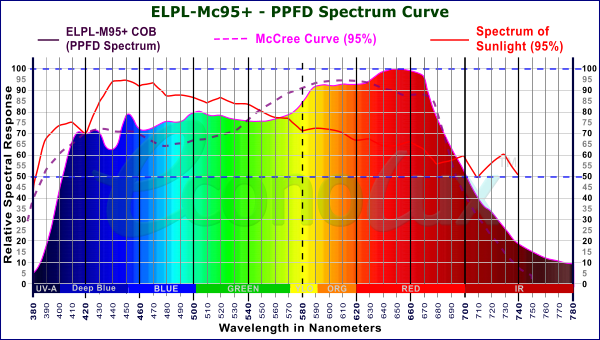 |
|
Mc95+
Comparison Graphs
The graphs (below), from our plant/grow light spectrometer, measuring in PPFD (PAR)*, shows a comparisons of the ELPL-Mc95+
100W COBTM spectrum, to various standard curves for Chlorophyll A, Chlorophyll B, and Beta
Carotene - the light absorbing compounds in plants responsible for growth.
The Mc95+ COB grow-light engine's match to these curves is
almost perfect due to the ELPL-Mc95+ COBs careful construction
with 24 bands of LEDs, and
the use of our self-developed and proprietary phosphor coating.

|
UV (380~399nm) |
BLUE
(400~499nm) |
GREEN
(500~599nm) |
RED
(600~700nm) |
Infra Red
(701~780nm) |
TOTALS |
| 16.45 PPFD |
261.55 PPFD |
293.14 PPFD |
326.31 PPFD |
69.33 PPFD |
966.78 PPFD |
| 1.70% |
27.05% |
30.32% |
33.75% |
7.17% |
100% |
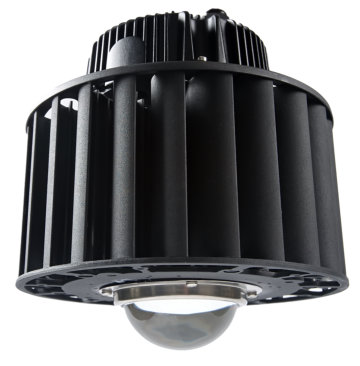 |
 |
|
PRO-LEDTM
100W Grow-light with Mc95+ COB & 90° lens
|
200W Mc95+ COB Grow-light on a chip |
|
|
Mc95+ Premium 24 Band COB - SPECIFICATIONS |
|
ELPL-Mc95+ Light-engine Parameters |
100 Watts |
200 Watts |
|
Nominal Wattage:
|
100 W |
200W |
|
Power: (constant current driver recommended) |
30VDC @ 3.35A |
30VDC @ 6.6A |
|
Dimensions:
|
56mm X 52mm X 4.5mm |
82mm X 82mm X 6mm |
|
LED Lifespan:
|
50,000 Hours |
|
Colour Temperature: (Kelvin) |
5,679K |
|
Illuminance:#1 (Measured using the CIE curve) |
46,593 Lux |
791,052 Lux |
|
Beam Angle: |
120°#1 |
|
Total PAR/PPFD* Output: |
966.78 @ 30.5cm (12") |
1,885.22 @ 30.5cm (12") |
|
DLI: (Daily Light Integral - mol/m2/day) |
62.02 @ 30.5cm (12") |
120.3 @ 30.5cm (12") |
|
Efficiency#2 (@ 30.5cm - 12"):
Using a quantum PAR meter; with NO reflector or lens used |
2.97 µmol/J |
|
Efficiency#2(@ 30.5cm -
12"): Using a quantum PAR meter; with NO reflector or
lens used |
9.66 PPFD/Watt |
9.43 PPFD/Watt |
*Note 1: Light energy for plants is measured as Photosynthetic Active Radiation (PAR),
with light falling onto a surface measured as Photosynthetic Photon Flux Density (PPFD)
#1 Note: These measurements were made at a distance of 30.5cm, (12") with no lens
or reflector used. Readings will vary with distance from the COB, and the use of supplementary
optics (reflector/lens). The spectrum of the COBs may vary by +/- 2% due to minor
variations in the LED chips output.
#2 Note:
We provide the electrical efficiency in industry standard µmol/J,
and we also use PPFD/Watt as most professional plant/grow light manufacturers provide the
average PAR/PPFD and the actual power draw (wall watts), making it simpler to compare different lights (measured at the same
distance from from the light to the PAR/PPFD meter).
|

|
|
Mc Series 100 Watt COB Comparison Table |
|
MODEL |
TYPE |
AVG.
MATCH |
MATCH RANGE |
OUTPUT
PPFD |
OUTPUT
DLI |
EFFICIENCY 1 |
EFFICIENCY 2 |
COST |
DETAILS
(Click the link) |
|
(to
The McCree Curve) |
|
Mc85 |
PCB COB |
85% |
84.5%~85.8% |
810.15 |
40.7 |
8.10 PPFD/W |
3.15 µmol/J |
Low |
Mc85 COB |
|
Mc90 |
PCB COB |
90% |
91%~93.5% |
685.08 |
52.9 |
6.85 PPFD/W |
2.74 µmol/J |
Med-low |
MC90 COB |
|
Mc95+ |
Standard COB |
95% |
94.5%~96.8% |
966.78 |
63.02 |
9.66 PPFD/W |
2.97 µmol/J |
Premium |
MC95+ COB |

|
ELPL-HPSH Low Cost, High Pressure Sodium light helper, 100 Watt PCB COBs |
 |
The HPSH (High Pressure Sodium Helper) LED COBs are available in 100W and custom size/configuration models.
It
is well known that HPS lamps, while useful for growing plants, have an
overabundance of green to yellow-orange light, but are deficient in other wavelengths of light which are vital to plants, especially flowering plants.
The HPSH COBs are intended to provide supplemental UV, Blue, Deep Red, and Infra Red (IR) light that is missing
from the usual HPS lamp spectrum. By combining a recommended 4 pieces (400W) of HPSH COBs, in suitable
fixtures, with each 1,000W HPS lamp, the spectrum of the HPS lamps can be improved, thereby increasing crop yields.
|
 |
Spectrum
The ELPL-HPSH COB Series of light-engines has an unusual spectrum, as it is
designed as a supplementary light to add to a High Pressure Sodium light. Note that it emits UV light
in the 390~410nm range, abundant blue light in the 410 ~ 470nm range (with a peak at 440nm), some Orange light
from 590~630nm, abundant Red light from 620~700nm, and strong Far Red and Infra Red light output from
700~780nm (with a peak at 735nm).
These are all wavelength which the HPS lamps do not produce, or which they produce weakly with insufficient
light for the plant's needs - especially flowering plants.
|
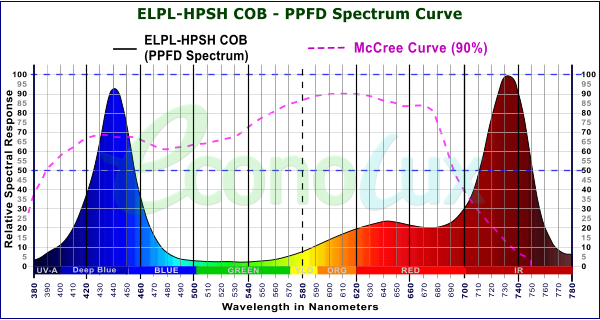 |
This spectrum (right) shows the output of a typical 1,000 Watt High Pressure Sodium grow-light - Note
that it produces almost no UV light, and only miniscule amounts of Blue light. While the HPS light does produce some red light in the
620~700nm orange to red range, the red light output falls off rapidly around the crucial 660nm wavelength and the HPS
light produces almost no Infra Red Light (700~780nm).
This lack of UV, Blue, Far Red and Infra Red light is less than ideal for growing plants, especially flowering plants which need
additional Red light, and take advantage of the 'Emerson Effect' when IR light is available to the plants.
|
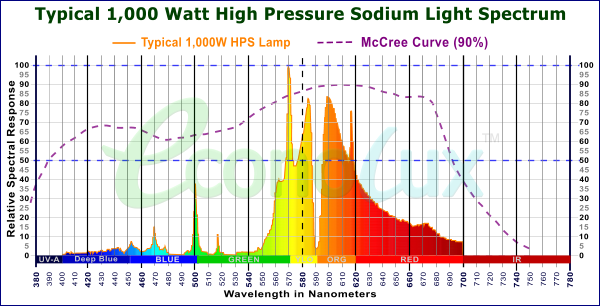 |
The spectrum on the right shows the results when combining the recommended 4 pieces (400W) of HPSH COB lights with a typical
1,000 Watt HPS Lamp. The effect of the HPSH lights can be increased by adding 6 HPSH COB lights (600W), or the
supplementary effect can be decreased by adding only 2 HPSH COB lights (200W).
You will note that there is now an increase in the UV and blue light in the 390nm to 490nm range, as well as a
slight increase in green light, an increase in Red light around the 630~680nm range, and a large increase in
Far Red light in the 720nm to 755nm range, so that flowering plants can take advantage of the 'Emerson effect',
which increases photosynthesis. |
 |
HPSH Comparison Graphs
The graphs (below), from our plant/grow light spectrometer, measuring in PPFD (PAR)*, shows a comparisons
of the ELPL-HPSH 100W COB spectrum, to various standard curves for Chlorophyll A, Chlorophyll B, and Beta Carotene - the light absorbing
compounds in plants responsible for growth. These graphs are not particularly useful as the HPSH
COBs/Lights are intended as supplemental to HPS lamps.

|
UV (380~399nm) |
BLUE
(400~499nm) |
GREEN
(500~599nm) |
RED
(600~700nm) |
Infra Red
(701~780nm) |
TOTALS |
| 15.72 PPFD |
242.54 PPFD |
24.63 PPFD |
140.68 PPFD |
292.27 PPFD |
715.57 PPFD |
| 2.20% |
33.89% |
3.40% |
19.66% |
40.84% |
100% |
|
|
ELPL-HPSH - SPECIFICATIONS |
|
ELPL-HPSH Light-engine Parameters |
100 Watts |
|
Nominal Wattage:
|
100 W |
|
Power: (constant current driver recommended) |
30~32VDC @ 3.35~3.1A |
|
Dimensions:
|
45.5mm X 40mm X 2mm |
| Mounting hole Grid dimensions (4
holes of 3.4mm diameter for M3 screws) |
34mm X 34mm |
|
LED Lifespan:
|
50,000 Hours |
| Active light emitting area (works
with mounts & lenses for typical 100W COBs) |
23.3mm X 23.3mm |
|
Colour Temperature: (Kelvin) |
0K |
|
Illuminance:#1 (Measured using the CIE curve
- NO reflector or lens used) |
7,173 Lux |
|
Beam Angle: |
120°#1 |
|
Total PAR/PPFD* Output: |
715.57 @ 30.5cm (12") |
|
DLI: (Daily Light Integral - mol/m2/day) |
35.48 @ 30.5cm (12") |
|
Efficiency #2:
Using a quantum PAR meter; NO reflector or lens used |
2.76 µmol/J |
|
Efficiency
#2
(at 30.5cm - 12"): Using a quantum PAR meter; NO reflector or
lens used |
71.5 PPFD/Watt |
*Note 1: Light energy for plants is measured as Photosynthetic Active Radiation (PAR),
with light falling onto a surface measured as Photosynthetic Photon Flux Density (PPFD)
#1 Note: These measurements were made at a distance of 30.5cm, (12") with no lens
or reflector used. Readings will vary with distance from the COB, and the use of supplementary
optics (reflector/lens). The spectrum of the COBs may vary by +/- 2% due to minor
variations in the LED chips output.
#2 Note:
We provide the electrical efficiency in industry standard µmol/J,
.and we also use PPFD/Watt as most professional plant/grow light manufacturers provide the
average PAR/PPFD and the actual power draw (wall watts), making it simpler to compare different lights (measured at the same
distance from from the light to the PAR/PPFD meter). |

|
CUSTOM COBs
EconoLux can design custom COBs to suit your needs and
budget. In the past we have designed COBs with a 95% match to the PAR curve. We have
designed special tomato growing COBs with a proprietary spectrum
(as specified by the client) that increased crop yields by 18% to 22%. We
have designed custom UVA COBs with wavelength output between 360nm and 395nm.
We can design any COB, either based on a conventional COB
holders, or a PCB style COB. Please
contact us to discuss your needs.
ELPL-Mc and HPSH Series LED COB Power Connections
The diagram below shows the power connections for the ELPL Mc series,
and HPSH series, COBs. Care
should be taken when soldering wires to the COB not to overheat the solder
pads, and to use standard electrostatic precautions (EG: grounded wrist
straps).

|























